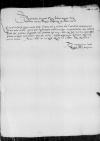List #6349
Sigismund I Jagiellon do Ioannes DANTISCUSBrest-Litovsk, 1544-10-12
| odebrano Wormditt (Orneta), 1544-10-21 Rękopiśmienne podstawy źródłowe:
| ||||
Tekst + aparat krytyczny + komentarzZwykły tekstTekst + komentarzTekst + aparat krytyczny
Reverendo in Christo Patri, domino
Reverende in Christo Pater, sincere nobis dilecte.
Studium Vestrae Paternitatis in bonis nostris Pucensibus redimendis tam gratum nobis accidit, quam fuit
Quae bene valeat.
Dat(ae) or Dat(um)()⌈Dat(ae)Dat(ae) or Dat(um)()⌉
in
Ex commissione sacrae regiae maiestatis propria


 BCz, 1601, p. 504
BCz, 1601, p. 504